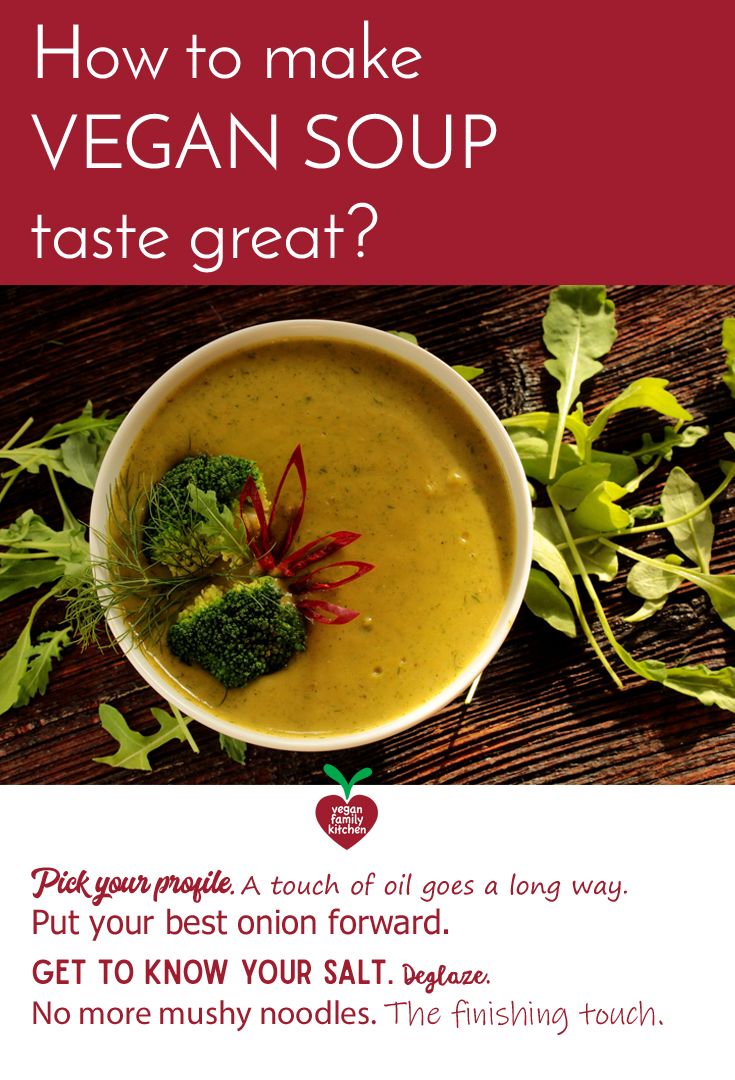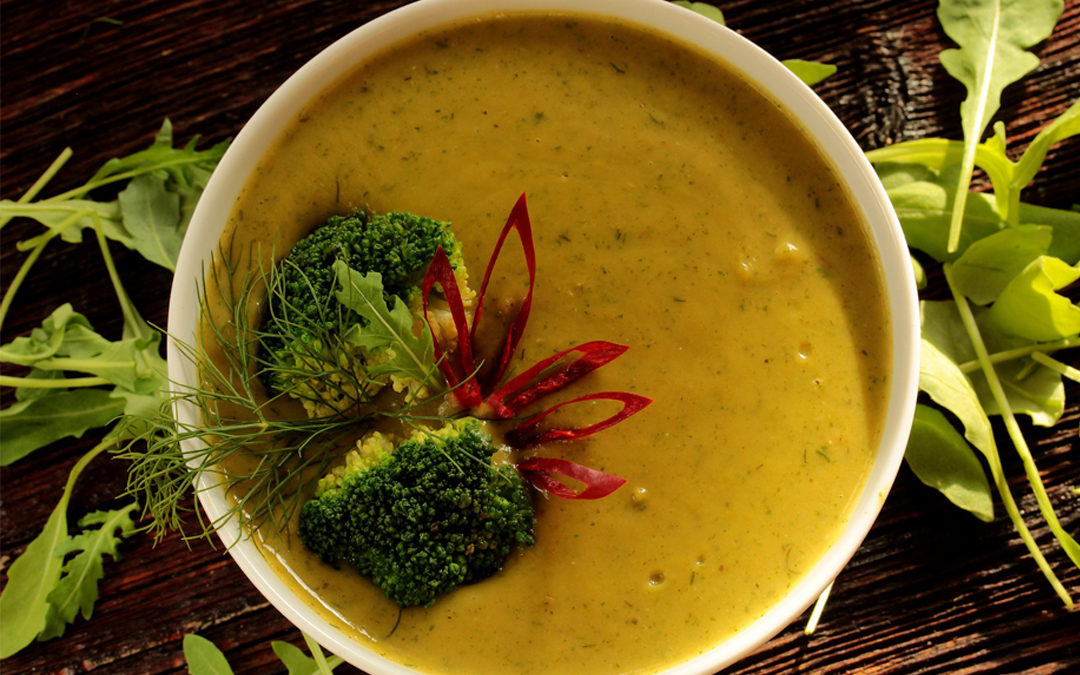Soup is such a beautiful thing. It is warm, filling, comforting, and can be quite inexpensive to make. It can catch all the leftover veggies in your produce drawer before it’s too late. Best of all, it can be delicious and nutritious too. But how to make vegan soup taste great?
I enjoy soup and, thankfully, my kids do too. In fact, they often say: “Mom, this is the best soup ever.” The weird thing is that I do not follow a recipe, and the ingredients change all the time, along with the seasons. Still, almost regardless of what I do, it’s always the “best soup.” I’ll take it!
Follow these tips and you will also achieve your best soup ever.
1. Pick your profile.
Look at what you have in the fridge and pantry and make a few quick decisions. Got carrots, parsley, tomatoes and beans? Add a bit of garlic, maybe little noodles, and make it a minestrone-style soup. Got tofu, bok choy, and coconut milk? Add some ginger, curry, and cooked noodles and call it Thai soup! Black beans, celery, and tomatoes? Add lots of cumin, some oregano and green onions for a Mexican soup.
Keep it simple and save experimentation for another dish. This is especially true if you have kids. Soup, after all, should be comforting – not unsettling.
2. A touch of oil goes a long way.
It is not fashionable these days to use oil in cooking, and I am certainly not one to deep-fry anything at home. The is no doubt in my mind that oil is over-used and abused in the processed food industry. Restaurants, even fancy ones, also use it quite liberally because it does enhance the eating experience. Sadly, the unlucky people among us who rely on convenience food for nourishment are likely to be consuming quite a bit more fat from oil than they should, and their hearts and other organs pay the price. With so few people eating meals cooked from scratch at home, no wonder oil gets pointed out as an evil ingredient to be banished entirely.
Nevertheless, oil serves a purpose. Until recently, I thought the primary function of oil in cooking was to prevent food from sticking. Indeed, oil can save dish washers from having to scrub pots for hours, but for that purpose it can easily be replaced by water or a little bit of broth. The actual function of oil is to convey the fat-soluble nutrients from our food to our bloodstream. And it so happens that all those vitamins go hand in hand with taste. Of course, most of the fat we consume should be straight from plant products, such as seeds and nuts. The benefit of using a little bit of oil in cooking is help with the extraction and transport of nutrients – and flavor – from spices and herbs which otherwise would go straight through our digestive tube.
If most of the food you eat is cooked at home, and unless your doctor says otherwise, don’t sweat the use of a teaspoon of olive or coconut oil in the making of your soup. Add it to a medium-hot pot as you sweat the onion and other vegetables. The oil will catch the molecules of carotenoids (essential for our vegan bodies to create vitamin A) as well as vitamins E and K, and carry them to your bloodstream.
3. Put your best onion forward.
A few years ago, I switched my shopping habit from buying 5-pound bags of so-called cooking onions to choosing individual, large yellow sweet onions such as Walla Walla. The taste of my soups, stews and curries has greatly improved as a result! Nearly every recipe I make, except for the occasional stir-fry, starts with cutting the stem end of a big, firm onion. I then halve the beast and slice it, also occasionally dicing it. I then cook the onion on medium heat for at least 5 minutes, 10 or more whenever possible, in a teaspoon of oil and with a big pinch of salt. The salt helps release the moisture from the onion and accelerates the caramelization of the onion’s sugar, lending a subtle sweet flavor to any dish. Whatever you do, don’t burn the onions. Golden is what you are aiming for.
4. Get to know your salt.
We have come to fear salt just as much as we fear oil, for the same reasons. Salt allows industrial food companies to increase the shelf-stability of their products and grow their profit margins, but in excessive amounts it can throw off our bodies’ chemistry and lead to long term health problems. Again, if most of the food you eat is cooked at home, you do not need to worry about a reasonable amount of salt used in cooking (unless your doctor advises otherwise).
But salt isn’t salt isn’t salt! Regular table salt is very fine and a teaspoon of it may bust your soup, whereas a teaspoon of coarse sea salt in in fact quite a bit lighter and may actually not be enough. They also taste quite different. My kids get their iodine from seaweed, so I don’t bother cooking with iodized salt. At the moment, I use medium-grain sea salt. I like the taste, too! Whatever you do, going a (big) pinch at a time and tasting often is essential, especially when getting used to a new salt.
When making soup, I add a generous pinch of salt with the addition of every vegetable I sauté, then I give it a break until almost the very end. In recipes, that step is usually called: “Taste and adjust seasoning.” Since I often use powdered bouillon that does include salt, I occasionally find myself with a bit too much saltiness, in which case I can just add a cup of water to stretch and dilute the soup a little, or an extra potato. Apparently, a cup of cooked rice would work too, but I have never tried that. But, most of the time, it’s just lovely as-is.
Even if a soup is just perfect, a tiny sprinkle of finishing salt like fleur de sel adds a nice touch. My husband used to laugh and call it snob salt… but now he puts it everywhere. Those little flakes are worth their weight.
5. De-what? Deglaze.
When you cook your veggies at the right temperature in that medium-hot pan, you (perhaps unwittingly) cause a Maillard reaction. I am no chemist, but I can tell you that it’s where the magic comes from. The Maillard reaction is the cascade of transformations that happens when proteins and sugars are married by heat. And since there is indeed plenty of protein in plants, this is bound to happen when you sauté the vegetables to start your soup! You know it’s starting because a mouth-watering aroma fills the air of your kitchen and some golden brown bits start to develop on your vegetables… and on the bottom of your pan. Those brown bits are sugar, and they should NOT be abandoned to the dish water! In fact, properly deglazing your pot or pan will not only release more wonderful flavors into your soup, it will also make scrubbing practically unnecessary.
How do you do it? All you need is a few tablespoons, let’s say 2 to 4, of a cold liquid. My favorites to use are lemon juice, apple cider vinegar (which I would perhaps mix with broth or water), and white wine, but you can also use any liquid that is matched in color with the soup you are making… or even water. If I was making a beefy barley soup, I would probably use beer. Butternut squash soup calls for orange juice in my book. A Thai-style curried soup would do well with lime juice. The juice squeezed out of a tomato also usually works great.
Pour the cold liquid into the pot and stir well, scraping the bottom of the pan at the same time. I find a wooden spatula to do the best job here – a spoon won’t work. If you push the veggies to the side and can see the pretty-much-clean metal of your pot underneath, you have done a great job.
6. No more mushy noodles.
If you add noodles to your soup, they should be al dente to provide some contrast. If using pasta like orzo, shells, alphabet or little stars, only add them once your soup is practically ready, and cook for half of the time indicated on the package. They will finish cooking with the residual heat even after you turn off the element. If using Asian-style rice vermicelli, udon or soba, cook the noodles separately per the package directions, perhaps on the slightly undercooked side. Then, place the noodles at the bottom of your bowl and use a ladle to pour the hot soup on top.
7. The finishing touch.
Boring soup? Add a splash of lemon or lime juice to brighten, or perhaps deepen the flavor with a subtle drizzle of oil (toasted sesame seed for an Asian-flavored soup, olive oil for a minestrone). Now’s also a good time to add some sliced green onions, chives, or even olives! Croutons (a fancy word for diced toasted bread) also work wonders. On Asian soups, a few sprouted beans bring a welcome crunch. Smooth soups will become decadent with the addition of a swirl of cashew cream. Yum!
What’s your favorite soup?
Love it? Pin it!




